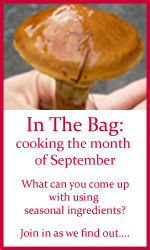 Tagine is probably Morocco's best known dish and most famous export, it is a combination of meat (usually lamb but sometimes chicken), fruit, sweet spices, hot spices and often aromatic flavours like rose petals. I can't remember exactly when I first tried tagine but I do vividly remember how the melt in the mouth tender meat, sweet and spicy flavour and the amazing smell simply blew me away, it was as they say love at first bite and I've been hooked ever since.
Tagine is probably Morocco's best known dish and most famous export, it is a combination of meat (usually lamb but sometimes chicken), fruit, sweet spices, hot spices and often aromatic flavours like rose petals. I can't remember exactly when I first tried tagine but I do vividly remember how the melt in the mouth tender meat, sweet and spicy flavour and the amazing smell simply blew me away, it was as they say love at first bite and I've been hooked ever since. If you're going to make tagine yourself it well worth trying to get hold of a spice blend called ras-el-hanout (I really like this one). Ras-el-hanout roughly translates as top of the shop, so called because the spice sellers in the souks of Morocco blend their very best spices to make it. There are no rules as to what goes in to ras-el-hanout, it can contain up to and over twenty ingredients but there is almost always cinnamon, cumin, coriander, and chili, the blend I'm using contains all manner of good things including rose petals, lavender, cloves and ginger, it smells amazing!
If you're going to make tagine yourself it well worth trying to get hold of a spice blend called ras-el-hanout (I really like this one). Ras-el-hanout roughly translates as top of the shop, so called because the spice sellers in the souks of Morocco blend their very best spices to make it. There are no rules as to what goes in to ras-el-hanout, it can contain up to and over twenty ingredients but there is almost always cinnamon, cumin, coriander, and chili, the blend I'm using contains all manner of good things including rose petals, lavender, cloves and ginger, it smells amazing!This is my recipe for tagine, it is highly adaptable and I change it depending on what I have in the cupboard, you could add black olives, preserved lemon and you just have to have some kind of dried fruit, I really like dried apricots in this but prunes are delicious too.

- Olive oil
- 2-3 medium onions roughly chopped
- 4 cloves of garlic peeled and crushed to a paste
- 3 tsp Ras-el-hanout or 1 tsp each of ground cinnamon, cumin and coriander
- 1 small red chilli chopped (add more or less depending on how hot you want it)
- 1 tin (400g) of chickpeas drained
- 1 pint of stock (any kind)
- 1 tin (400g) of chopped tomatoes
- Half a shoulder of lamb on the bone
- 3 medium carrots peeled and chopped into large chunks (you could use squash or sweet potato)
- A good handful of dried apricots
- Salt and pepper
- A large handful of chopped fresh coriander
- In a large pan over a gentle heat soften the onions in a little olive oil.
- Add the garlic, chilli and spices to the pan and cook for a minute more.
- Add the chickpeas, stock and tomatoes, mix well and bring to a simmer.
- Add the lamb, carrots and apricots, season to taste and put in a low oven for 3-4 hours until the lamb falls off the bone.
- Stir in the coriander just before serving and serve with cous cous or flatbread.










































